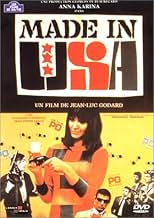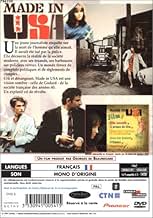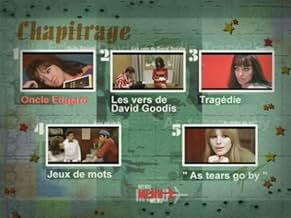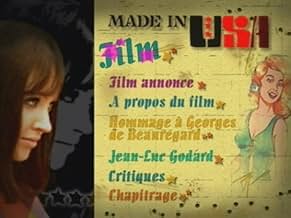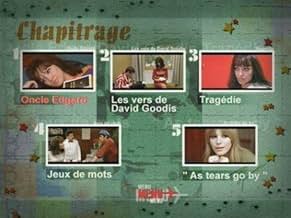Paula Nelson deberá investigar en Atlantic City (Francia) la muerte de su amante, investigación que se presentará peligrosa debido a la atención que ésta consigue despertar entre los mafioso... Leer todoPaula Nelson deberá investigar en Atlantic City (Francia) la muerte de su amante, investigación que se presentará peligrosa debido a la atención que ésta consigue despertar entre los mafiosos de la ciudad.Paula Nelson deberá investigar en Atlantic City (Francia) la muerte de su amante, investigación que se presentará peligrosa debido a la atención que ésta consigue despertar entre los mafiosos de la ciudad.
- Dirección
- Guionistas
- Elenco
- Paula Nelson
- (as AK)
- Richard Widmark
- (as LS)
- Donald Siegel
- (as JPL)
- David Goodis
- (as YA)
- Man with Marianne Faithfull
- (sin créditos)
- Policeman
- (sin créditos)
- Richard Nixon
- (sin créditos)
- Inspector Aldrich
- (sin créditos)
- Bill Poster
- (sin créditos)
- Barman
- (sin créditos)
- Workman in bar
- (sin créditos)
- Dental Assistant
- (sin créditos)
- Richard Politzer
- (voz)
- (sin créditos)
- Robert MacNamara
- (sin créditos)
- Girl in Bandages
- (sin créditos)
- Doris Mizoguchi
- (sin créditos)
- Self
- (sin créditos)
- Dirección
- Guionistas
- Todo el elenco y el equipo
- Producción, taquilla y más en IMDbPro
Opiniones destacadas
The often curious soundtrack features a passing jet aircraft (or is it an express train?) which always obscures the surname of Karina's mysterious, deceased lover in a fashion that Tarrentino late used to obscure the name of the'The Bride' in KILL BILL.
What's it all about? No idea! But the film, or maybe the style, certainly the luminous Karina, does somehow get under your skin and even though I found it hard to endure on a first viewing I'm increasingly keen to watch it once again . Amongst the mind-boggling strangeness I'm sure I must have missed something vital....now, where is that DVD?
Made in USA, so Godard claims, is a remake of the Big Sleep. But, and it should be noted up top, I don't think we can believe him. Part of the fun is dealing with how he will lie to you, treat you with contempt, and/or in general mess with your head. There are constant interruptions in the film, Godard forces you to face the fact you are watching a film and to size it up constantly. Godard doesn't exist to watch on auto pilot; he wants you to analyze the act of viewing. It can be infuriating, especially when he removes action sequences or very awkwardly names characters/places "Otto Preminger" or "Richard Widmark." The political statements get a little heavy handed as well, though treated with humor.
As much fun as I find the film, and this entire period of Godard, watching a film like this or Pierrot Le Fou or 2 or 3 Things About Her or Weekend is work. You are expected to be actively involved. If you want to be told a story or feel like you are looking into another world, maybe Made in USA is not for you. And that's cool, these films are obnoxious and pretentious. But it can be extremely rewarding if you are willing to admit you may not "get" chunks of the film and maybe enjoyment will only kick in after thinking about the movie for a couple days. That sounds like faint praise, but Made in USA is an audacious, bold, exciting film that makes you confront what you always took for granted in classic Hollywood.
Neon signs and electronic news ribbons proliferate. So do comic strips and film stills. Most of the characters, like Donald Siegel and Doris Mizoguchi, are named for Godard's favorite movie figures, and allusions to American movie characters are everywhere, including three from three separate films by Otto Preminger, who also has a street named for him in the movie's make-believe Atlantic City. This stunningly self-conscious political diatribe's cinephilic gags and cartoon violence smack of Alphaville.
In her final performance for Godard, Anna Karina is Paula Nelson, a P.I. swathed in an overcoat and packing heat. As The Big Sleep has an infamously indecipherable plot, one of whose many murders not even Hawks could clarify, so this is Godard's most unrelentingly unbalanced of plot convention. Crucial scenes, if you can call them that, are systematically minced right at the moment of revelation. Information in the dialogue is resolutely buried by street noise or two brash Beethoven chords, as, variantly seductive and apathetic, Paula goes looking for an ostensibly vanished lover, likely dead, in a tangled, tortuous, never elucidated international political conspiracy.
Supposedly, Godard had much more than Raymond Chandler and Donald E. Westlake on one's mind. This patchwork mingles the Americanization of French life with the widespread controversy of mid-60s France, the vanishing of Morocco's foremost leftist, a political expatriate in France and a third-world personage then akin to Malcolm X or Che Guevara, kidnapped by French police acting in cahoots with the Moroccan government, which evidently had him tortured to death on French terrain. That he disappeared while traveling to a development meeting for a documentary, made the incident even more dramatic for Godard. Supposedly, this work of sociopolitical meta fiction is an imagining that he'd not died but had hidden in the provinces, wrote to his girlfriend to meet him. When she gets there, she discovers him dead.
So the movie starts with Paula secluded in a shoddy hotel room in the characterless Paris suburb that doubles for Atlantic City, reflecting on her state of affairs while a couple of hooligans, played by New Wave regulars László Szabó and Jean-Pierre Léaud, linger portentously under her window. "Hanging out" is one of the movie's "active" (if that word could be used) factors. This awkward satire has characteristics of the sometimes fascinating, sometimes pedantic time-languishing revue that distinguished the art-house of the '60s. Early on, Marianne Faithful sits inexplicably in a neighborhood café, nonchalantly trilling As Tears Go By a cappella. But chiefly, Raoul Coutard's camera stares at the star, a statue. Frankly, you could forget all about the political and sociological vinegar and find the movie's really all about contemplating Karina's concealed grins, her dark hair, her switching clothes, and her eerie ability to turn any given shot into a fashion promo. Considering that we hear her voice-over all over, it's not unlike a Jarmusch-esque lone wolf enterprise.
Plot, to use the term carelessly, accelerates when Paula slays the irritating midget stoolie Mr. Typhus: "Now fiction overtakes reality," she self-narrates. Storytelling is leaps and bounds more complicated and theoretically brutal here as in The Big Sleep or Kiss Me Deadly. Like Marlowe or Hammer, Paula finds a succession of corpses during her mission. She also leaves a footpath of others as her own upshot, including one whom she just shoots at close range. Later on, she serves the movie's most celebrated, and loaded, line: "We were in a political movie. Walt Disney with blood." Roughly when characters named Nixon and McNamara show up as hoodlums, played by young film critics, the reel-to-reel tape recorders that have been sporadically stationary in close-up to play messages left by Paula's lover change to egalitarian discourse.
The movie is anti-capitalist and anti-consumerist, condemning miniskirts and rock and roll as manner of fascist brainwashing, but more invested in the kitschy modernism favored by the informal consensus within the mainstream of Western culture than any movie Godard made prior or since. Paula asserts that advertising is a form of fascism, representing the director. It's a legitimate grievance and an upsetting one, considering that Made in U.S.A. is a relentless commercial for itself. Perhaps the cleverest thing about it might be its title, which offers perspective on that element.
Pending this work, Godard was a nationalist for some, a populist for others, but didn't folks assert the same thing about Orson Welles? And yet for others, he was just an armchair politico. Made in U.S.A. is an opinionated exploit that's equally as sincere as a formal expression of political will, a judgmental breakdown of pop culture and a cautionary lecture in which, this time, the filmmaker has become so explicitly caught up that he felt he had to film it himself.
Do not watch this movie late at night or while doing anything that will cause you to glance away from the screen. Every moment in this film is necessary, every word that Godard has our actors speak - while at times confusing and thought provoking - is needed to tell this dis-narrative story. Godard is a master behind the camera for this film - giving us an early glimpse as to what was in store with "Pierrot Le Fou", his bold color and well read characters (each one is always holding a book - Bravo!), are just the crust. What made "Made in USA" stand out was the obvious connections to Walt Disney, the "Big Sleep", and nearly everything coming out of the 60s in America, but what makes Godard impressive, is that one needs to search to see it. He doesn't spoon feed you a narrative that makes your heart gush at the end, Godard creates challenging cinema that will not be enjoyed by all, but if developed - if watched over time - if studied, remains important even 43 years later.
"Made in USA" is another Criterion release that looks and sounds perfectly, but - even with my discussion on how great Godard's work is - isn't the greatest release from the master. Yep, I am a Godard fan, but I am picky. I didn't enjoy "Breathless", but "Pierrot Le Fou" I hold very highly - and this - well, "Made in USA" is intelligent, but perhaps a bit too pretentious. The idea behind this film is solid, but it is the execution that had me nervous. Godard is eloquent in introducing us to certain characters and elements, but gives them names of his favorites like McNamara and Nixon that just feels weighted by symbolism and inside jokes. The viewing took place over the course of three days, not due to the diminishing subject, but because a rewind was needed to ensure that parts didn't go missing or lost. Crafting one part puzzle, one part social commentary, one part comedy is difficult - and for the beginning film watcher - this probably isn't the best film to first experience Godard. Here is what I liked - I loved not knowing. What was exhilarating about this feature was the unknown. The confusing dialogue, the menacing tape voice, the constant barrage of planes flying overhead (if that IS what that noise was), and the possible hope of knowing Richard's last name - keeps one wanting to finish, but getting there is a battle. The dialogue is either a love or hate moment. As there is no linear story, from the spoken perspective, and it is easy to get lost in Godard's cluttered words. For myself, it was at times refreshing - and at other times a disaster. Without a linear narrative, it was difficult to understand how one character fit within the scheme of events. What was happening between Paula and Mr. Typhus? Just thinking about it gives me a headache.
The scenes that stood out in this film were the bartender moments (where you could call him Paul or Bartender, but not "sir"), the pinball machine in the garage, and the billboard store room characters. These made me chuckle and see the humor that Godard was demonstrating, but the others just felt murky and disjointed. Again, I would like to state that every scene was necessary, but were they great? The imagery was spectacular - giving us the color palette that he would later use in "Pierrot Le Fou" - and the cinematography followed suit. For me, it was just the language the bogged me down. I wanted to know these characters further, I wanted to further know the story of the skulled man, and who was double crossing who. "Made in USA" is an important film, I am glad to see it within the Criterion catalogue, but it is an advanced film. The average film watcher will not like this movie, even I felt lost sometimes - but I am so very happy that I watched it.
In another review, this film was quoted as a "B-side" to the Godard cannon, and I couldn't agree more. Could I watch this movie again? Absolutely, but not right away. I look forward to re-exploring this piece of cinema, understanding what I missed, and seeing the inside moments that may have slipped by me the first time. "Made in America" isn't perfect, and I don't know anyone that can take a ten minutes of a tape playing discussing politics, but this self-proclaimed "B-side" finally has a release it deserves.
Grade: *** 1/2 out of *****
Paula (Anna Karina), a journalist, goes to a small town where her estranged boyfriend Richard has died in mysterious circumstances, surely murder. Determined to get to the bottom of things, she takes on the air of a hardboiled detective, wielding a pistol and wearing a Bogartian trenchcoat. She meets the doctor who did the autopsy and has a run-in with the police, but mainly we see her tangled up with two gangsters, played by László Szabó and Jean-Pierre Léaud.
Godard maintains just enough conventional dialogue and action to let the viewer know where we are in the crime novel's plot, but most of what transpires before the camera must be understood as only abstract metaphors for what would have happened in the book. The interaction between his characters mainly has other purposes. They have absurdist conversations with a great deal of wordplay. They allude to French politics in a time when Godard was worried about the compromised values of the French Left and the spectres of fascism and consumer society. The Ben Barka affair, where a Moroccan dissident was murdered in France in 1965 with the apparent involvement of the French security services, looms very large over MADE IN U.S.A., almost elbowing Westlake's original story out entirely. As if aware that he had stripped the plot down to such a degree that he now had too much time to be filled, he gives little asides like Marianne Faithful singing "Tears Go By" a cappella in a cameo and Kyôko Kosaka strumming a guitar and singing in Japanese.
This is not one of Godard's best films. For one, Godard reused many of the elements of his masterpiece PIERROT LE FOU from the year before. PIERROT LE FOU was itself assembled as sort of a collage of shots from Godard's prior films, which worked well as a wonderful summing up of his early career. But when he does the same with MADE IN U.S.A., it is to greatly diminished effect. But even if this is weak by Godard standards, it is nonetheless a moving experience. Shot in colour and in Cinemascope, this is a feast for the eyes. The very best of what the 1960s had to offer in terms of fashion and product design is on hand here and it just jumps of the screen. The image feels electric. (It is a pity that Criterion's edition is only on DVD, as a Blu-Ray would have yielded even greater pleasures.) Godard's longtime cameraman Raoul Coutard gives us some elaborate long takes that impress. And of course it's Godard's last major celebration of Anna Karina's beauty and poise, which really was something for the ages, still stunning half a century later.
¿Sabías que…?
- TriviaThough based on "The Jugger" by Richard Stark (Donald E. Westlake), the author received no compensation for this adaptation. Westlake, who passed away at the end of 2008, successfully kept the film from being shown in the US during his lifetime.
- Citas
Marianne Faithfull: It is the evening of the day / I sit and watch the children play / Smiling faces I can see / But not for me / I sit and watch / As tears go by / My riches can't buy everything / I want to hear the children sing / All I hear is the sound / Of rain falling on the ground / I sit and watch / As tears go by / It is the evening of the day / I sit and watch the children play / Doing things I used to do / They think are new / I sit and watch / As tears go by
- ConexionesEdited into Bande-annonce de 'Made in U.S.A.' (1966)
- Bandas sonorasAs Tears Go By
Written by Mick Jagger, Keith Richards and Andrew Loog Oldham
Performed by Marianne Faithfull
Selecciones populares
- How long is Made in U.S.A?Con tecnología de Alexa
Detalles
Taquilla
- Presupuesto
- USD 50,000 (estimado)
- Total en EE. UU. y Canadá
- USD 95,209
- Fin de semana de estreno en EE. UU. y Canadá
- USD 11,147
- 11 ene 2009
- Total a nivel mundial
- USD 95,304
- Tiempo de ejecución1 hora 30 minutos
- Mezcla de sonido
- Relación de aspecto
- 2.35 : 1
Contribuir a esta página





